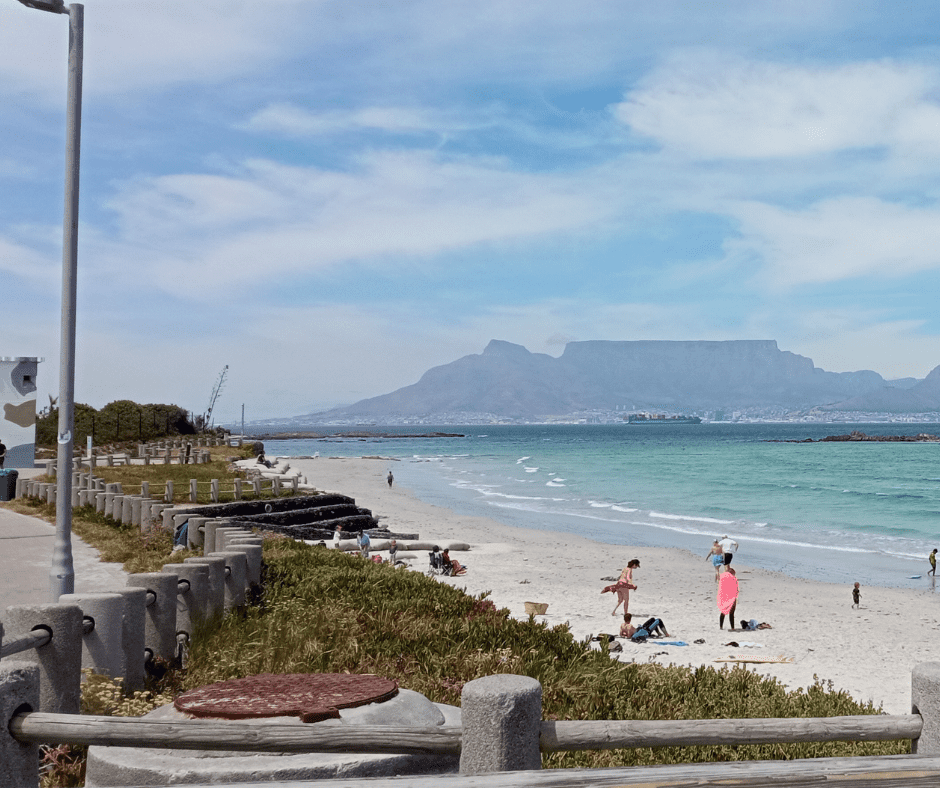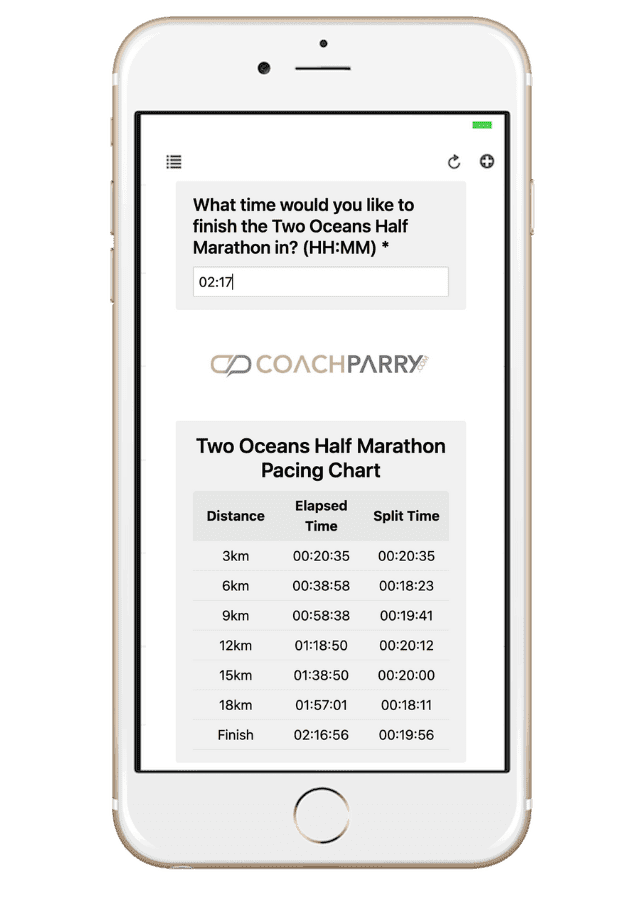With the Total Sports Two Oceans Marathon in just a few days, it’s extremely important that you begin to tie off loose ends and bring the final days of your training together by planning your perfect Two Oceans Marathon race day strategy.
Important editors note: If you are running the Two Oceans Ultra Marathon, we have created a similar route and pacing guide for the 56k, and you can access that by clicking here.
In this article, we’re going to have a detailed look at the Two Oceans half-marathon route and the best way for you to tackle the course.
We will also cover exactly how you can calculate your perfect pacing strategy with a pacing chart that has been created just for you.
Let’s get started!

The Two Oceans Half Marathon
Pacing during the Two Oceans Half Marathon is important because if you go out too hard from the start line… which is very easy to do as one gets caught up in all the race excitement… this will lead to you really struggling later in the race.
The Two Oceans Half Marathon is not one of the easiest half marathons for runners to complete. It is what we refer to as a net uphill run, meaning you start lower than you finish and there are 3 proper hills to navigate on the route.
The challenge in the Two Oceans Half Marathon lies in the fact that you have to account for the 50/60 meters gained from the start to the finish as well as the big climbs along the way.
Let’s have a look at the Two Oceans Half Marathon course description…
The Two Oceans Half Marathon Route: The ESSENTIAL Course Guide
The good news is that it’s not a traditional mass gun to mat start, meaning they are going to have separate starts with each wave, and there are going to be 1000 runners in each wave. So there’s still going to be a little bit of time between the last runner in the wave and the first run in the wave, but it’s going to be seconds rather than minutes.
This allows you to plan your race much better. It means that you’re not trying to catch up for a few lost minutes.
One of the important things to note about the Two Oceans Half Marathon is that the race start is quite challenging.
Runners start on Main Road, which is slightly uphill, you won’t notice that because it’s probably the flatter part of the whole route… just before runners reach Cavendish they turn right onto Protea Road, where they will begin a gradual uphill all the way to Paradise Road.
As you approach Paradise Road runners turn left onto Edinburgh Drive, what I call Wynberg Hill… this is a really long, hard climb. Coming up to the 5km mark.
In the past, it was still quite dark at this point because the race began extremely early due to being on the same day as the Ultra, but this year, because they have a later start the sky should be lightening up by now.
From here, runners head down the M3, this is a nice, fast section of the route on the highway. When runners head off the highway they turn onto Kendal Road at about 7 km.
Runners then run along Spaanschemat River Road, next to the Constantia Pick ‘n Pay. A U-turn is done as runners head back and turn right into Ladies Mile extension, which takes them over Constantia main road to Parish road where they pass the little old stone church on their right-hand side.
Once on Southern Cross Drive, runners will run on the nontraditional route, they used to have to turn right at the bottom of Southern Cross Drive but now they are required to turn left, And obviously, that makes it sound like you’re going to do less climbing. But there’s another little change at the top of Southern Cross Drive.
Southern Cross Drive is the “grand-daddy” of the half marathon, Wynberg Hill was tough, but it was quite early… Southern Cross Drive is really long, measuring around 2.7 kilometers.
It’s steep and really hard to run up in some sections, particularly as you get to the top.
The new section of the route actually extends the climb by another 50 to 70 meters. Once at the top, you do a U-turn onto Newlands Avenue, where you get a chance to recover as it’s mostly flat with a few little drags.
We refer to those drags as efforts one, two, and three.
As runners approach Kirstenbosch’s top gate with just over 4 K’s to go they hit a nice downhill which they can take advantage of, and fly past Kirstenbosch’s bottom gates.
Runners continue on the downhill until they have just over 2km to go. They then turn right onto Union Avenue (M3) and reach a 2 km climb up Chet’s Hill, it’s not a consistent climb, there are a few little breaks along the way.
And that is the last little bit of hard work and actually where you make up most of the net gain that you need to make up from starting on Main Road and finishing at UCT upper campus.
The finish itself is a little bit easier for runners as they turn off the M3 onto the UCT grounds. There’s a short little climb and then they sprint to cross the finish line on the grass field.
Now that we have a better understanding of the Two Oceans Half Marathon Route, let’s see exactly how to pace it.

Two Oceans Half Marathon Pacing Chart
Before we jump into the perfect pacing strategy, you’ll want to make sure you have a Two Oceans pacing chart to help you reach your goal.
Here at Coach Parry we’ve actually created a Two Oceans Half Marathon Pacing Chart that you can access for free by clicking here.
As mentioned above, the Two Oceans Half Marathon has a net elevation gain so you need to take that into account when planning your pacing chart.
The Two Oceans pace chart that we have created for you takes into about the elevation loss or gain from every kilometer on the route and then calculates the pace at which you need to run that kilometer at.
Two Oceans Half Marathon Pacing Strategy
The first thing that we have to acknowledge is that with the route being a net uphill, this means that if you want to run a barrier time, for example, a sub 2 hour, a sub 1 hour 45min, or a sub 90, you have to accept that there are parts of the route that you need to run faster than you should by conventional pacing standards.
You need to make up the net deficit that you’re going to incur from having a net uphill on your route.

Runners have effectively got three major climbs along the Two Oceans Half Marathon route that they need to tackle. Meaning the down hills need to be taken advantage of and more work needs to be put into the flats if you are aiming for a specific time.
The important thing is to get yourself in your groove as early as you can. In the past, there were a lot of sections where runners got bottlenecked on certain turns but this year, because of the batch starts it should play to your advantage.
So in terms of pacing, you need to get into your groove in terms of effort quite early in the race before you get to Protea Road.
You’ve also got to have a conservative start, if you overpower on that first long stretch up to 3 km you’re going to reach 5 km and begin to struggle… which is not what you want that early in the race. It’s also going to take away your opportunity of taking advantage of the downhills because your legs will be tired.
The long run down into Constantia along the M3 is a section where you want to start making up for the lost time.
When you then turn off the M3 onto Kendal Road, this is another part of the race where that’s a short climb, but you just want to maintain effort and not worry too much about your pace
Keeping an even effort through that section will then mean that you don’t blow out your legs.
Heading onto the flatter section of the course next, this is where you can run about 3 seconds faster per kilometer if you’re feeling strong. If you are feeling quite good in this section it’s a good sign that you are in good shape and probably have got a good chance of nailing your time.
When you then do the U-turn on Spaanschemat River Road, that’s the point at which you don’t want to power out of the turn too hard, build back up to speed over 30m and not the 1st 5m. The flat stretch will continue all the way until you reach Southern Cross Drive.
This next section is where most Two Oceans Dreams come to die… it’s an extremely tough climb and if you haven’t paced yourself correctly and saved your legs… you will find this section very challenging.
What you need to do here is save your legs so that you can take advantage of the four kilometers after the climb on the turnoff.
After that downhill section towards Newlands, you’ll reach the last little climb called Chet’s Hill. You can give whatever is left in your tank here knowing that within the next 10-15 minutes you will be finished with the race.
What we’ve done is looked at every single kilometer of the Two Oceans half marathon route and calculated whether it’s a net up or a net down and worked out exactly what you need to be doing for that kilometer. and then we’ve aggregated it all together.
It’s in 3-kilometer segments and allows you to enter your goal time and works out exactly what you need to run along each segment.
It’s important that you don’t put in… for example, five minutes ahead of your goal time hoping for the best but expecting that you’re gonna go five minutes slower, these pacing charts are worked out exactly for the goal that you want to run.
We recommend printing the ticket and getting it laminated so that you can run with it on race day.



Comments are closed.